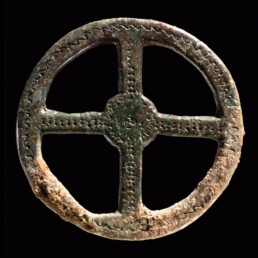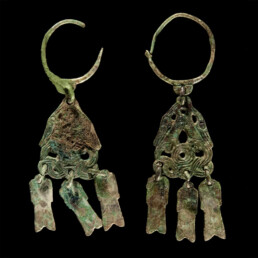Site of Christianisation
The Sülchen excavations have made it possible to look deep into the early times of the German southwest and thus considerably expand our knowledge of the Christianisation of southwest Germany. The finds from around eighty graves show that the area around Rottenburg was not only inhabited since prehistoric times, but can also be counted among the important sites of the Christianisation of Alamannia. The grave goods from the 6th and 7th centuries, which the soil revealed and which are now being presented to the public in the newly built Sülchen Museum, illustrate an epochal transition: a girl’s grave contains a Charon’s penny, which was presumably given to the deceased according to pre-Christian custom as ferry money for her journey to the afterlife, as well as early Christian evidence. Thus, the cross amulets express faith in Jesus Christ as the Risen One and reveal a gradually spreading Easter hope.
Among the early medieval burial treasures, which show striking references to Burgundy and the Frankish Empire, are precious decorated belt buckles, swords, knives and lances from men’s and boys’ graves as well as rich women’s jewellery with combs made of bone, strings of beads made of iridescent coloured glass and brooches. All these finds fascinate us in two ways: they open a window into the everyday world of the people of this distant time and at the same time touch on a question of humanity that has lost none of its topicality beyond the change of historical epochs – the question of death and the hereafter, of “What comes after?”
Walk through the eras
Not only the time of early Christianity is made present by the Sülchen finds: the following epochs have also left striking traces of their piety and a rich artistic heritage. Around 1000, a three-nave pillar basilica with a three-apsidal choir was built in place of the first church (around 680). This building was part of the cultural and spiritual upswing of the Ottonian period, for which magnificent works of art are characteristic. Liturgy, art and the claim to lordly sacral representation through church architecture made “a great leap” forward. This upswing, initiated in Sülchen by the noble family of the Hessons, continued into the Romanesque period. The present building of the Sülchen church dates from the middle of the 15th century and still breathes the atmosphere of urban late-medieval piety and provision for the afterlife.
The building also contains important Baroque artifacts – such as the painted epitaphs of Rottenburg noble and bourgeois families from the 17th century. The enduring burial tradition can be seen in the numerous graves of that era, which in turn yielded finds of cultural historical significance: The priests’ graves, for example, reveal the changing ideals of office and sanctity.
The same applies to lay and popular piety, the development of which is illustrated by numerous Baroque grave objects, including shab figures, saint medallions, Sebastian crosses and votive figures.
Almost a year has passed since the reopening of the Sülchenkirche in Rottenburg. Since then, visitors can visit the burial chamber with the deceased bishops and admire treasures from times gone by. Despite the reopening, investigations into the excavation treasures continued, and we were able to view some of them in September 2018.






